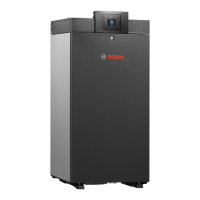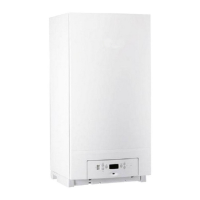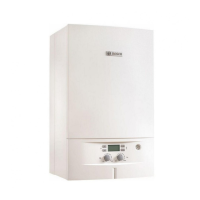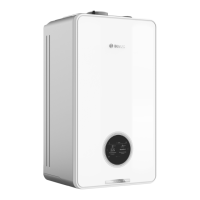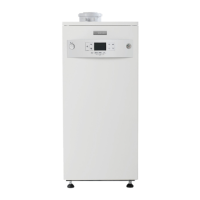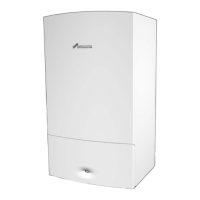Do you have a question about the Bosch Condens 7000 FP and is the answer not in the manual?
Defines signal words (DANGER, WARNING, CAUTION, NOTICE) indicating risk levels.
Instructions for contractors on compliance with regulations and safety procedures.
Designates the boiler for floor standing gas condensing central heating and DHW.
Lists the UK importer details for Bosch Thermotechnology Ltd.
Details allowed fuels, primarily municipal gas supply and natural gas with hydrogen.
Details checks upon receipt of packaging and provides disposal instructions.
Lists available accessories for the boiler system.
Lists necessary tools and aids for installation, commissioning, and maintenance.
Enables system operation and monitoring via mobile devices or PC.
General description of the boiler and its main components.
Illustrates boiler dimensions and connection points with diagrams.
Emphasizes adherence to applicable national, regional, and technical regulations.
Covers requirements for informing authorities and obtaining permits before installation.
States that modified or supplementary regulations are also valid and must be observed.
General notes on using genuine parts and observing local regulations for installation.
Details critical safety requirements for installation location, including risks from ammonia and flammable materials.
Highlights the importance of water quality for system efficiency, reliability, and warranty.
Addresses pipework quality, especially regarding plastic pipes and system types.
Advises keeping combustion air free from corrosive substances and dust.
Specifies requirements for combustion air openings and ventilation for safe operation.
Refers to control unit documentation for frost protection settings.
Describes burner removal to reduce transport volume and facilitate movement.
Provides safety warnings and procedures for transporting the boiler using a crane.
Details steps and safety precautions for lifting the boiler from its pallet.
Explains the method for rolling the boiler to its installation location.
Covers critical safety aspects for installation site, including explosion and fire risks.
Suggests using manufacturer-offered silencer options to minimize noise.
Addresses considerations for clearances when installing a single boiler unit.
Describes the process of levelling the boiler horizontally using adjustable feet for proper drainage.
Details condensate pipe installation, including siphon filling and safety warnings.
Explains the installation of an optional condensate neutraliser accessory.
Covers essential safety measures for flue gas connection, preventing leaks.
Details how to connect the air supply for balanced flue operation and related safety notices.
Provides instructions and warnings for hydraulic connections, ensuring no leaks.
Step-by-step guide for connecting the boiler's flow pipe.
Instructions for connecting the boiler's return pipe, including dirt filter fitting.
Describes connecting an expansion vessel to the drain connection for system safety.
Details the on-site installation of the safety assembly, including air vent and pressure gauge.
Explains how to connect a DHW cylinder to the boiler's flow and return lines.
Covers safety procedures and regulations for establishing the gas fuel supply.
Guides filling the heating system, leak checking, and venting, with multiple safety warnings.
Instructions for fitting the boiler's casing panels and hoods.
Details on mounting the control unit onto the boiler, following technical documentation.
Instructions for establishing a permanent power supply and routing cables safely.
Procedures for checking and adjusting the heating system's operating pressure, with safety notes.
Focuses on performing leak tests on the gas side, with explosion risk warnings.
Guidance on obtaining and recording essential gas parameters from the supplier.
Verifies the boiler's gas group setting against the supply and updates data plates if needed.
Step-by-step instructions for safely venting the gas line.
Emphasizes checking ventilation and flue gas connections for safety and compliance.
Describes how to check the closing function of the flue gas damper.
Outlines the initial steps to make the heating system operational.
Covers commissioning of the control unit and burner, referencing specific documentation.
Details the procedure for measuring and recording gas supply and static pressures.
Explains how to check and adjust the gas/air ratio by measuring CO2 levels.
Guides on performing CO2 adjustments at full load, specifying screw adjustments.
Describes how to adjust and check the CO2 level at low load conditions.
Details re-checking and correcting CO2 levels at full load, with safety warnings about incorrect settings.
Lists various measurements to be recorded during commissioning.
Specifies the maximum permitted flue resistance for the system.
Outlines the acceptable limits for CO content in flue gases.
Instructions for finalizing the flue gas test and transitioning to operating mode.
Describes how to set the standard display on the control unit.
Covers performing function tests, including ionisation current checks.
Details how to check for gas tightness while the burner is operating, with safety warnings.
Instructions for fitting the boiler's casing panels and hoods.
Describes the procedure for shutting down the heating system via the control unit.
Details the procedure for emergency shutdown using fuses or switches, prioritizing safety.
Outlines essential safety steps before inspection/maintenance, including power isolation.
Provides a visual guide identifying the main components of the boiler.
Lists general maintenance tasks like system checks and pipework inspection.
Details the procedure for conducting internal tightness tests on the gas system.
Explains how to perform the gas tightness test using a pressure gauge and foaming agent, with safety notices.
Guides on checking and maintaining the correct heating system operating pressure, with safety warnings.
Describes how to measure CO2 and CO content in flue gas for burner adjustment.
Provides step-by-step instructions for burner removal for maintenance, including safety precautions.
Details how to position the burner for easier maintenance access.
Guides on cleaning the heat exchanger, with crucial safety warnings regarding flue gas.
Covers checking and cleaning burner electrodes, including replacement and gap measurements.
Details testing the differential pressure switch for correct operation and safety.
Covers component replacement, including removal and fitting procedures.
Guidance on reassembling components in the correct order, including new gaskets.
Describes how to check for leaks under full load, with safety notices regarding short circuits.
Explains how to check the ionisation current for proper burner operation.
Details how to reset faults when the unit is in emergency mode, using the reset button.
Covers identifying fault conditions, clearing them, and addressing frost damage risks.
Provides instructions for resetting the pressure monitor and safety warnings related to deactivated functions.
Explains how to access and query the fault history, depending on the control unit.
Lists operating codes, their causes, test procedures, and recommended actions.
Details service codes, their potential causes, and troubleshooting steps.
Lists various fault codes generated by the control unit, with diagnostic procedures.
Explains the status indicator lights on the burner control unit regarding its operating condition.
Details testing the differential pressure switch's continuity when the fan is active.
Describes how to test the differential pressure switch's continuity when the boiler is switched off.
Provides comprehensive technical specifications for the boiler, including performance and dimensions.
Presents resistance values for temperature sensors at different temperatures, crucial for diagnostics.
Shows a graph illustrating hydraulic resistance based on flow rate.
Provides wiring diagrams for the control unit and burner control unit, essential for electrical work.
Illustrates the gas tightness and monitoring system schematic.
Explains the conversion of CO2 values to O2 for burner setting adjustments.
A template for documenting the results of commissioning work and measurements.
Forms for recording details of inspections and maintenance activities performed.
Legal notice regarding data processing, GDPR, and user rights.
Defines signal words (DANGER, WARNING, CAUTION, NOTICE) indicating risk levels.
Instructions for contractors on compliance with regulations and safety procedures.
Designates the boiler for floor standing gas condensing central heating and DHW.
Lists the UK importer details for Bosch Thermotechnology Ltd.
Details allowed fuels, primarily municipal gas supply and natural gas with hydrogen.
Details checks upon receipt of packaging and provides disposal instructions.
Lists available accessories for the boiler system.
Lists necessary tools and aids for installation, commissioning, and maintenance.
Enables system operation and monitoring via mobile devices or PC.
General description of the boiler and its main components.
Illustrates boiler dimensions and connection points with diagrams.
Emphasizes adherence to applicable national, regional, and technical regulations.
Covers requirements for informing authorities and obtaining permits before installation.
States that modified or supplementary regulations are also valid and must be observed.
General notes on using genuine parts and observing local regulations for installation.
Details critical safety requirements for installation location, including risks from ammonia and flammable materials.
Highlights the importance of water quality for system efficiency, reliability, and warranty.
Addresses pipework quality, especially regarding plastic pipes and system types.
Advises keeping combustion air free from corrosive substances and dust.
Specifies requirements for combustion air openings and ventilation for safe operation.
Refers to control unit documentation for frost protection settings.
Describes burner removal to reduce transport volume and facilitate movement.
Provides safety warnings and procedures for transporting the boiler using a crane.
Details steps and safety precautions for lifting the boiler from its pallet.
Explains the method for rolling the boiler to its installation location.
Covers critical safety aspects for installation site, including explosion and fire risks.
Suggests using manufacturer-offered silencer options to minimize noise.
Addresses considerations for clearances when installing a single boiler unit.
Describes the process of levelling the boiler horizontally using adjustable feet for proper drainage.
Details condensate pipe installation, including siphon filling and safety warnings.
Explains the installation of an optional condensate neutraliser accessory.
Covers essential safety measures for flue gas connection, preventing leaks.
Details how to connect the air supply for balanced flue operation and related safety notices.
Provides instructions and warnings for hydraulic connections, ensuring no leaks.
Step-by-step guide for connecting the boiler's flow pipe.
Instructions for connecting the boiler's return pipe, including dirt filter fitting.
Describes connecting an expansion vessel to the drain connection for system safety.
Details the on-site installation of the safety assembly, including air vent and pressure gauge.
Explains how to connect a DHW cylinder to the boiler's flow and return lines.
Covers safety procedures and regulations for establishing the gas fuel supply.
Guides filling the heating system, leak checking, and venting, with multiple safety warnings.
Instructions for fitting the boiler's casing panels and hoods.
Details on mounting the control unit onto the boiler, following technical documentation.
Instructions for establishing a permanent power supply and routing cables safely.
Procedures for checking and adjusting the heating system's operating pressure, with safety notes.
Focuses on performing leak tests on the gas side, with explosion risk warnings.
Guidance on obtaining and recording essential gas parameters from the supplier.
Verifies the boiler's gas group setting against the supply and updates data plates if needed.
Step-by-step instructions for safely venting the gas line.
Emphasizes checking ventilation and flue gas connections for safety and compliance.
Describes how to check the closing function of the flue gas damper.
Outlines the initial steps to make the heating system operational.
Covers commissioning of the control unit and burner, referencing specific documentation.
Details the procedure for measuring and recording gas supply and static pressures.
Explains how to check and adjust the gas/air ratio by measuring CO2 levels.
Guides on performing CO2 adjustments at full load, specifying screw adjustments.
Describes how to adjust and check the CO2 level at low load conditions.
Details re-checking and correcting CO2 levels at full load, with safety warnings about incorrect settings.
Lists various measurements to be recorded during commissioning.
Specifies the maximum permitted flue resistance for the system.
Outlines the acceptable limits for CO content in flue gases.
Instructions for finalizing the flue gas test and transitioning to operating mode.
Describes how to set the standard display on the control unit.
Covers performing function tests, including ionisation current checks.
Details how to check for gas tightness while the burner is operating, with safety warnings.
Instructions for fitting the boiler's casing panels and hoods.
Describes the procedure for shutting down the heating system via the control unit.
Details the procedure for emergency shutdown using fuses or switches, prioritizing safety.
Outlines essential safety steps before inspection/maintenance, including power isolation.
Provides a visual guide identifying the main components of the boiler.
Lists general maintenance tasks like system checks and pipework inspection.
Details the procedure for conducting internal tightness tests on the gas system.
Explains how to perform the gas tightness test using a pressure gauge and foaming agent, with safety notices.
Guides on checking and maintaining the correct heating system operating pressure, with safety warnings.
Describes how to measure CO2 and CO content in flue gas for burner adjustment.
Provides step-by-step instructions for burner removal for maintenance, including safety precautions.
Details how to position the burner for easier maintenance access.
Guides on cleaning the heat exchanger, with crucial safety warnings regarding flue gas.
Covers checking and cleaning burner electrodes, including replacement and gap measurements.
Details testing the differential pressure switch for correct operation and safety.
Covers component replacement, including removal and fitting procedures.
Guidance on reassembling components in the correct order, including new gaskets.
Describes how to check for leaks under full load, with safety notices regarding short circuits.
Explains how to check the ionisation current for proper burner operation.
Details how to reset faults when the unit is in emergency mode, using the reset button.
Covers identifying fault conditions, clearing them, and addressing frost damage risks.
Provides instructions for resetting the pressure monitor and safety warnings related to deactivated functions.
Explains how to access and query the fault history, depending on the control unit.
Lists operating codes, their causes, test procedures, and recommended actions.
Details service codes, their potential causes, and troubleshooting steps.
Lists various fault codes generated by the control unit, with diagnostic procedures.
Explains the status indicator lights on the burner control unit regarding its operating condition.
Details testing the differential pressure switch's continuity when the fan is active.
Describes how to test the differential pressure switch's continuity when the boiler is switched off.
Provides comprehensive technical specifications for the boiler, including performance and dimensions.
Presents resistance values for temperature sensors at different temperatures, crucial for diagnostics.
Shows a graph illustrating hydraulic resistance based on flow rate.
Provides wiring diagrams for the control unit and burner control unit, essential for electrical work.
Illustrates the gas tightness and monitoring system schematic.
Explains the conversion of CO2 values to O2 for burner setting adjustments.
A template for documenting the results of commissioning work and measurements.
Forms for recording details of inspections and maintenance activities performed.
Legal notice regarding data processing, GDPR, and user rights.

